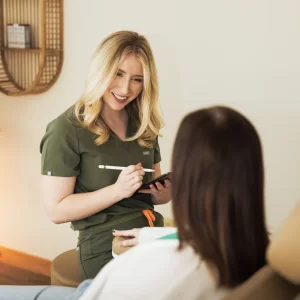In the world of cosmetic enhancements, Antiwrinkle (Botox/Dysport) and dermal fillers are often mentioned together, yet they serve distinct purposes with different applications and effects. If you’re considering these treatments but are unsure of the differences, read on to learn more about Botox, fillers, and how they can enhance your appearance in unique ways.
Defining Antiwrinkle and Fillers
Botox: Botox, short for Botulinum Toxin Type A, is a neurotoxin derived from bacteria. It is used in cosmetic treatments to temporarily paralyze muscles, thereby reducing the appearance of wrinkles caused by facial expressions. Botox works by blocking nerve signals to the muscles, preventing them from contracting and forming wrinkles.
Fillers: Fillers, also known as dermal fillers or soft tissue fillers, are injectable substances designed to add volume and fullness to targeted areas of the face. They can help wrinkles and fine lines, plump lips, enhance shallow contours, and improve the appearance of scars. Fillers are commonly made of hyaluronic acid.
Specific Uses and Effects of Each Treatment
Botox:
- Uses: Botox is primarily used to treat dynamic wrinkles, which are wrinkles that form from repeated muscle movements, such as frown lines, forehead lines, and crow’s feet around the eyes.
- Effects: It temporarily relaxes the muscles, smoothing out wrinkles and preventing them from deepening over time. Results typically last around 3 to 4 months before a touch-up is needed.
Fillers:
- Uses: Fillers are versatile and can address a variety of concerns including adding volume to cheeks and lips, smoothing nasolabial folds (smile lines), marionette lines, and rejuvenating hands.
- Effects: Depending on the type of filler used, results can last anywhere from 6 months to 2 years or more. They provide immediate volume enhancement and can stimulate collagen production in the skin for longer-lasting benefits.
Targeted Areas for Botox and Fillers
Botox:
- Ideal for treating dynamic wrinkles around the eyes (crow’s feet), between the eyebrows (glabellar lines), and on the forehead.
- Also used for non-cosmetic purposes such as treating excessive sweating (hyperhidrosis) and migraines.
Fillers:
- Commonly used to add volume and fullness to areas such as lips, cheeks, chin, and temples.
- Effective in filling in static wrinkles (wrinkles present at rest) and enhancing facial contours.
Important Distinctions Between Botox and Fillers
- Mechanism of Action:
- Botox works by temporarily paralyzing muscles to reduce wrinkles caused by facial expressions.
- Fillers work by adding volume to targeted areas, smoothing out wrinkles and restoring youthful contours.
- Duration of Results:
- Botox results typically last around 3 to 4 months.
- Fillers can last from several months to over a year, depending on the type of filler used and the area treated.
- Immediate vs. Gradual Results:
- Botox results become noticeable within a few days to a week after treatment.
- Fillers provide immediate volume enhancement, with ongoing improvements in skin quality over time due to collagen stimulation.
Understanding these key differences between Botox and fillers can help you make informed decisions about which treatment or combination of treatments best suits your aesthetic goals. Consult with a qualified healthcare provider or cosmetic injector to discuss your options and create a personalized treatment plan tailored to enhance your natural beauty effectively and safely. Whether you’re looking to smooth out wrinkles or restore youthful volume, Botox and fillers offer versatile solutions to help you achieve your desired look.

